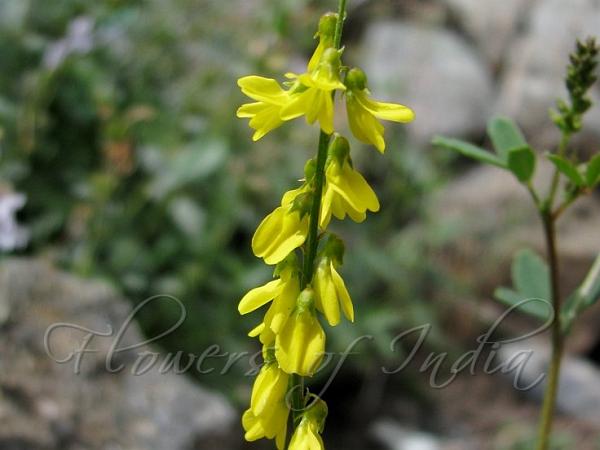|
| Yellow Sweet Clover |
|

|

| File size | 55684 |
| Original date | 9/15/11 1:28 PM |
| Resolution | 736 x 552 |
| Flash | Flash did not fire, auto |
| Focal length | 6.0mm |
| Exposure time | 1/1250s |
| Aperture | 2.7 |
| Focus Distance | |
| Metering Mode | Center weighted average |
| Camera make | Canon |
| Camera model | Canon PowerShot S5 IS |
| Sensor type | OneChipColorArea |
|
|
|
|
Photo: |
Botanical name: Melilotus officinalis Family: Fabaceae (Pea family)
Yellow Sweet Clover is an annual or biennial plant, stems
2-4 ft tall, longitudinally ridged. Stipules are linear-sickle shaped,
3-5 mm, entire or with 1 tooth at base; leaf-stalk slender. Leaves are
trifoliate, leaflets obovate, broadly ovate, inverted-lanceshaped, to
linear, 15-25 x 5-15 mm, lateral veins running into teeth, 8-12 pairs,
margins shallowly sawtoothed. Flowers are borne in racemes 6-15 cm long,
30-70-flowered, dense at first, becoming lax in anthesis; bracts equal
to flower-stalks, 1.5-2 mm. Flowers are yellow, 4.5-7 mm; standard equal
to wings and keel. Pods are ovoid, 3-5 x about 2 mm. Yellow Sweet Clover is
found in Europe to West Himalaya. Flowering: May-September.
Medicinal uses:  Yellow Sweetclover is considered to be very
helpful in removing gas from the digestive system and in inducing
urination. It can improve blood circulation, and be of great help in
treatments of varicose veins and hemorrhoids. It can also be helpful
in treatments of wounds, cuts and bruises. Used in form of a tea,
Yellow Sweetclower is beneficial in cases of nervous tensions, painful
menstruation, insomnia and palpitations.
Yellow Sweetclover is considered to be very
helpful in removing gas from the digestive system and in inducing
urination. It can improve blood circulation, and be of great help in
treatments of varicose veins and hemorrhoids. It can also be helpful
in treatments of wounds, cuts and bruises. Used in form of a tea,
Yellow Sweetclower is beneficial in cases of nervous tensions, painful
menstruation, insomnia and palpitations.
 Yellow Sweetclover is considered to be very
helpful in removing gas from the digestive system and in inducing
urination. It can improve blood circulation, and be of great help in
treatments of varicose veins and hemorrhoids. It can also be helpful
in treatments of wounds, cuts and bruises. Used in form of a tea,
Yellow Sweetclower is beneficial in cases of nervous tensions, painful
menstruation, insomnia and palpitations.
Yellow Sweetclover is considered to be very
helpful in removing gas from the digestive system and in inducing
urination. It can improve blood circulation, and be of great help in
treatments of varicose veins and hemorrhoids. It can also be helpful
in treatments of wounds, cuts and bruises. Used in form of a tea,
Yellow Sweetclower is beneficial in cases of nervous tensions, painful
menstruation, insomnia and palpitations. | Identification credit: Prashant Awale | Photographed in Ladakh. |
• Is this flower misidentified? If yes,